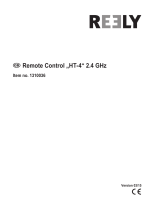
4.3.3 TRACKED V. model template ...................................................... 83
5 Menus ............................................................................................................ 86
5.1 Status displays ...................................................................................... 86
5.1.1 Status display #1 .......................................................................... 86
5.1.2 Status display #2 .......................................................................... 87
5.1.2.1 Battery status ........................................................................... 87
5.1.3 Status display #3 .......................................................................... 89
5.1.4 Status displays #4 to #8................................................................ 90
5.2 Menu structure ...................................................................................... 91
5.3 Setup main menu .................................................................................. 92
5.3.1 M-LINK .......................................................................................... 93
5.3.2 Flight phases ................................................................................ 94
5.3.3 Training (principle) ........................................................................ 96
5.3.3.1 Student mode ........................................................................... 96
5.3.3.2 Teacher mode .......................................................................... 97
5.3.4 Sensors ......................................................................................... 99
5.3.4.1 Variometer ................................................................................ 99
5.3.4.2 Vibra.Alarm............................................................................. 100
5.3.4.3 Edit name ............................................................................... 100
5.3.5 Assign.Controls ........................................................................... 101
5.3.6 Assign.Switches .......................................................................... 102
5.3.6.1 TriggerPoint ............................................................................ 102
5.3.6.2 MagicSwitch ........................................................................... 104
5.3.6.3 Switch ..................................................................................... 104
5.3.7 Define mixer ................................................................................ 105
5.3.7.1 Name ...................................................................................... 105
5.3.7.2 Mixer inputs ............................................................................ 105
5.3.8 Transmitter .................................................................................. 109
5.3.9 User data .................................................................................... 110
5.4 ControlFunctions main menu .............................................................. 112
5.4.1 Aileron, Elevator, Rudder............................................................ 115
5.4.2 Throttle (fixed-wing models, vehicles, boats, and funcopters) ... 117
5.4.3 Throttle (helicopter) ..................................................................... 118
5.4.3.1 Throttle curves (Governor OFF) ............................................. 119























